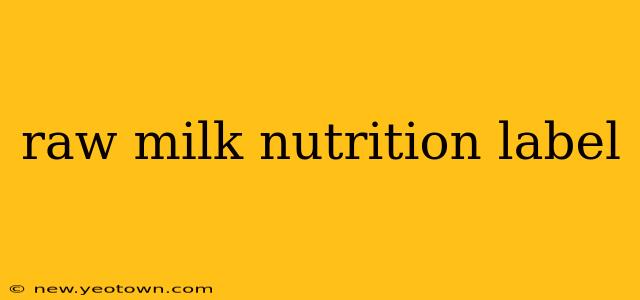Let's be honest, the world of raw milk can feel a bit…wild. One minute you're sipping creamy goodness, the next you're knee-deep in debates about pasteurization and potential risks. But nestled within this controversy lies a fascinating question: what exactly is on a raw milk nutrition label, and what does it all mean? This isn't just about numbers on a page; it's about understanding the nutritional profile of a product with a history as rich (and sometimes as risky) as its flavor.
This journey begins not with a definitive label, but with a crucial understanding: raw milk nutrition labels vary. There's no single, standardized label across all farms and producers. This inherent variability is part of the appeal for some, and a source of concern for others. Consistency is often sacrificed at the altar of farm-fresh authenticity. But let's explore what information you might find, and what it suggests.
What to Expect (and Not Expect) on a Raw Milk Nutrition Label
A typical raw milk nutrition label will likely mirror that of pasteurized milk, offering information on serving size, calories, fat, protein, carbohydrates, and sometimes vitamins and minerals. However, the values themselves might differ subtly. This is because raw milk's composition fluctuates based on factors like cow breed, diet, season, and even the individual cow's health.
Here's what you'll likely see:
- Serving Size: Usually 8 ounces (240ml).
- Calories: Around 150-160 calories per serving, often slightly higher than pasteurized milk due to variations in fat content.
- Fat: This can vary significantly, depending on the breed of cow and their diet. It's usually higher than in reduced-fat or skim pasteurized milk.
- Protein: Similar to pasteurized milk, providing a good source of protein.
- Carbohydrates: Naturally occurring sugars (lactose) are present in raw milk.
- Vitamins and Minerals: Raw milk advocates often highlight higher levels of certain vitamins and enzymes compared to pasteurized milk, but rigorous scientific confirmation on significant differences is often debated. Labels may list some key vitamins (A, D) and minerals (calcium, potassium), but this is not always the case.
What you WON'T typically see (and why):
- Precise Vitamin and Enzyme Content: As mentioned, the variability makes it challenging to consistently list precise amounts.
- Guaranteed Consistency: This is the core difference. The inherent natural variation in raw milk means that each batch isn't exactly the same.
Frequently Asked Questions About Raw Milk Nutrition
Now, let's address some common questions that often pop up when people delve into the world of raw milk nutrition labels and beyond:
1. Is raw milk healthier than pasteurized milk?
This is a complex question with no simple answer. While proponents of raw milk often cite higher levels of certain nutrients and enzymes, it's crucial to acknowledge the potential health risks associated with consuming unpasteurized dairy. Pasteurization eliminates harmful bacteria, but it also reduces some nutrients. The choice boils down to an individual's risk tolerance and assessment of the potential benefits versus risks.
2. Does the raw milk nutrition label indicate potential pathogens?
No. A raw milk nutrition label does not provide information about the presence or absence of harmful bacteria or pathogens. This is a crucial point. The label focuses on nutritional content, not safety. The responsibility for ensuring the safety of raw milk rests with the producer and the consumer.
3. Are there any specific vitamins or minerals significantly higher in raw milk?
Some studies suggest that raw milk may contain higher levels of certain vitamins like vitamin K2 and certain enzymes. However, research on this remains ongoing and often inconclusive. The variations in levels make it difficult to consistently claim significantly higher levels in raw milk compared to pasteurized options.
4. How can I find reliable information about raw milk safety?
For information on the safety of raw milk, consult reputable sources such as your local health department or agricultural agencies. They can offer guidance on regulations and potential risks associated with consuming raw milk.
5. Why aren’t raw milk nutrition labels standardized?
The lack of standardization stems from the nature of raw milk itself. Unlike pasteurized milk, where processing creates a uniform product, raw milk's composition varies naturally, influenced by several factors, making it difficult to provide consistently accurate label information.
In conclusion, understanding raw milk nutrition requires navigating a landscape of variability and potential risks. While the nutritional profile may show some potential benefits compared to pasteurized milk, prioritizing safety and consulting reliable sources remains paramount. The label provides a glimpse into the nutritional composition, but it's crucial to remember that it does not guarantee safety.

